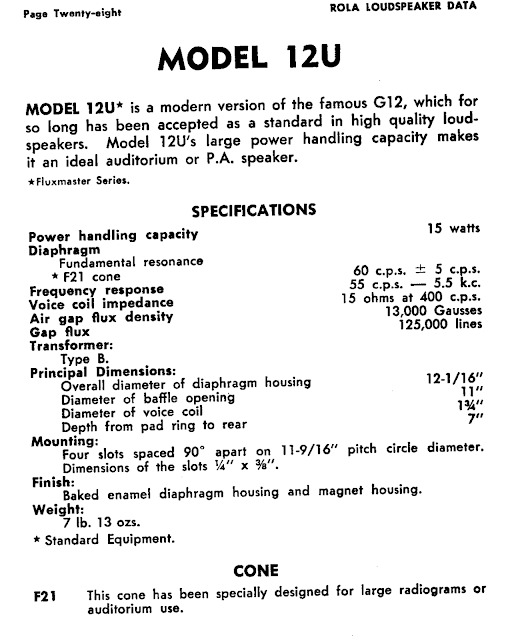Rola is better known as an American speaker maker, but there was also Rola Australia, based in Melbourne, which made speakers, transformers, chokes, and other related items. They also produced speakers in the UK and NZ. As a local manufacturer of quality products, Rola Australia found its way into many Australian-made guitar amps. Their biggest sellers were used in console valve radios back in the day.
Plessey Electronics took over Rola in the sixties and continued to make speakers locally through to the mid-seventies. During this period, their speakers were branded as Rola / Plessey.
The 12U, 12 PEG, and 12 UEG are the most desirable Rola speakers, as they were specifically made for guitars. The 12M is also popular, but at 10 watts peak, it's cutting it close for even a small 4-watt valve amp, given how we like to run them hard these days.
I've saved the Rola catalogs here if anyone is interested, as I've just taken a few screen grabs of the bits that interest me to use in this post.
ROLA ELECTRIC GUITAR SPEAKERS
ROLA 12-O
ROLA HI-FI SPEAKERS
Some folks also like the dual cone models, as they're very close to the guitar speakers, with the addition of a 'whizzer' cone to help with high frequencies. Despite being Hi-Fi speakers, these do show up in some old amps. They are a bit bright for some, as the do have quite an extended range compared to a regular guitar speaker.ROLA TRANSFORMERS
ROLA DATES CODES
Care of P Field, https://www.aggh.net/discussion/index.php?topic=49255.0
The date code is an ink-stamp on the rim of the speaker frame, and it consists of a series of numbers and letters. First is a one or two digit number for the day. Next is a letter for the month, as follows:
A = January
B = February
C = March
D = April
E = May
F = June
G = July
H = August
I = September
J = October
K = November
L = December
This is followed by a single digit number, which is the least significant digit (last digit) of the year. Sometimes this is followed by another letter, which possibly indicates the person who stamped it. The decade is not specified by the code, and the same date codes get reused each decade. The date code 1A2, for instance, was used for the 1st January in the years 1942, 1952, 1962 and 1972. To determine the decade, features such as the label, model, magnet type (alnico or ceramic), finish etc. can be helpful.




















2 comments:
Not to be confused with a random guy on Ebay selling amps saying "Rola" that are $5000+ and seem to contain a lot of very cheap components and have a reputation of being poorly built, and the builder gets super defensive when anyone remotely knowledgeable points any issues out with the build
Oh right - I have not seen those. Does he also make transformers?
Post a Comment